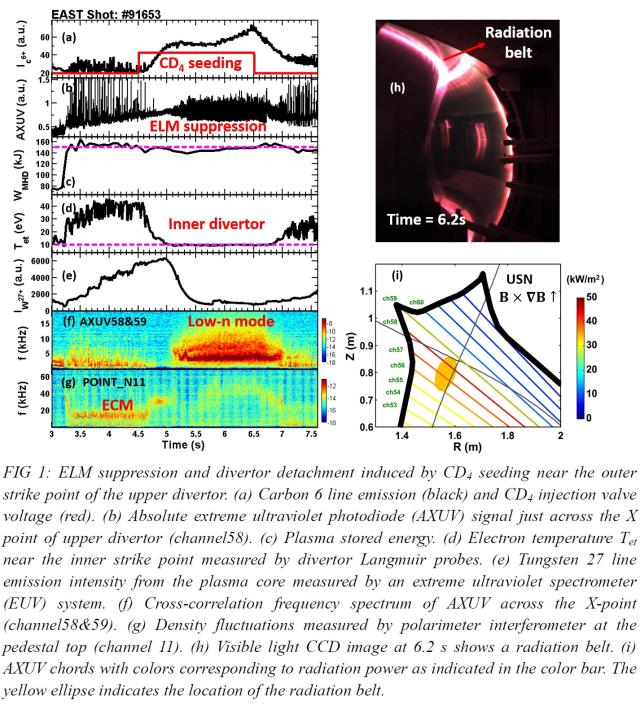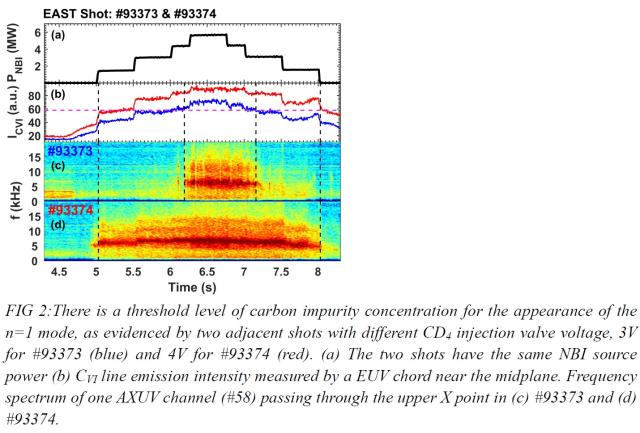Speaker
Description
Simultaneous control of large ELMs and divertor heat load in a metal wall environment is crucial for steady-state operation of a tokamak fusion reactor. A new scenario for ELM suppression compatible with radiative divertor has been demonstrated, for the first time, in the EAST superconducting tokamak. An n = 1 mode [FIG 1(f)] along with its harmonics, initiating from the oscillation of a radiation belt in the high-field-side SOL near the X point [FIG 1(h)&(i)], is excited during impurity seeding with CD4 from the upper divertor near the outer strike point in the H-mode plasmas at a sufficiently high impurity concentration. ELM suppression [FIG 1(b)] has been achieved robustly with the presence of this mode in a wide q95 range from 4.5 to 6.5 (Ip = 400-600 kA and Bt = 2.25, 2.47 T) and a wide heating power range with source power ranging from 3 MW up to 9 MW. Along with ELM suppression, divertor detachment has been achieved with target electron temperature Tet < 10 eV [FIG 1(d)] and significant reduction in ion saturation current at the inner target plate. The plasma stored energy keeps nearly constant [FIG 1(c)], indicating that good energy confinement is maintained. Active feedback control of either Tet or divertor radiation with impurity seeding has been demonstrated in this regime. Furthermore, high-Z impurity concentration, as indicated by tungsten (W) 27 line emission intensity from the plasma core [FIG 1(e)], is suppressed and maintained at a low level when the mode appears. The estimated W impurity confinement time is < 200 ms, which is significantly shorter than that in ELM-free H-mode plasmas, but close to that in typical ELMy H-mode or EDA H-mode plasmas on EAST. These may suggest that sufficient particle transport is driven across the pedestal so that a quiescent H-mode with a low impurity concentration can be maintained. The n = 1 mode drives particle transport as evidenced by oscillations in divertor Dalpha and ion saturation current signals and an increased pedestal foot density, which may be responsible for the sustainment of ELM suppression. However, the dominant pedestal fluctuations, Edge Coherent Mode (ECM) [1], in the ELMy phase are significantly reduced during CD4 seeding, as shown by polarimeter-interferometer measurements [FIG 1(g)], suggesting that the quiescent pedestal is not sustained by the ECM-driven transport.
This n = 1 mode has been observed only in H-mode and disappears as the heating power decreases down to near the L-H transition threshold power. Excessive impurity seeding also leads to mode suppression. These may suggest that the excitation of this mode requires a sufficiently high local temperature or radial temperature gradient. A clear threshold in the carbon impurity concentration for the mode excitation has been identified, as shown in FIG 2. Shots #93373 & #93374 are two adjacent discharges with the same operation conditions except for the CD4 injection valve voltage, 3V for #93373 and 4V for #93374. The mode appears in the time window when the CVI line radiation intensity exceeds a threshold, as indicated by the magenta dashed line in FIG 2(b). In addition, statistical analysis indicates that the CVI intensity threshold increases with heating power.
In addition to CD4 puffing, a similar n = 1 mode and its harmonics have been observed in EAST with helium, lithium, boron, neon and argon seeding, given a sufficiently high impurity concentration, although the mode excitation with argon and neon appears to be more difficult, especially for neon. We have only observed this mode with neon seeding in very limited high-power cases. Furthermore, the mode excited by CD4 puffing exhibits a broader frequency band (deltaf/fpeak > 50%), as shown in FIG 1(f) and FIG 2(c)&(d), with weak magnetic oscillations, while in other cases the mode is more coherent (deltaf/fpeak < 30%) with stronger magnetic oscillations. The oscillation is mostly localized near the main X point. However, it can extend to the midplane when the mode is strong, and especially at lower Ip. In the latter case, the mode is also detectable near the secondary X point. In addition to the mode in the high-field side SOL near the X point, another n = 1 mode sometimes appears in the low-field side SOL between the outer target and the X point when the outer target is partially detached.
A model based on impurity-radiation-driven drift instability has been developed to explain the excitation mechanism of this n = 1 mode. It is noted that there is a negative-slope Te range in the impurity radiation loss function, as shown in FIG 3(a) for carbon. In this Te range, radiation loss increases with decreasing Te as plasma is cooled by impurity radiation, leading to a further lower Te. This gives rise to the so-called ‘radiation condensation instability’ as the impurity concentration is sufficiently high [2]. In a strongly magnetized toroidal plasma, it couples to drift waves, which makes it more easily unstable. In tokamak divertor region, a localized cold, high-density, radiating plasma region (a radiation belt as seen toroidally) usually forms in the high-field-side SOL near the X point with impurity seeding. Before the radiating region intrudes into the closed flux surfaces, forming a confinement-degrading ‘X-point MARFE’, it can be maintained below the X point without degrading the pedestal confinement. The impurity-radiation-driven drift instability is destabilized as the local Te in the radiating region is reduced down to the negative-slope Te range in the impurity radiation loss function, given a sufficiently high impurity concentration. For carbon, the Te range is roughly 7.6-20 eV in the EAST case [FIG 3(c)]. The model predicted mode frequency and excitation conditions are consistent with the experiments quite well. In general, many impurity species have this negative-slope Te range, such as helium, lithium, carbon, boron, neon and argon, but their Te ranges are different. Neon and argon have relatively high Te ranges, 34-110 eV for neon and 19-54 eV for argon, which are more difficult to access in EAST with relatively low plasma density and impurity concentration, but is readily accessible in future large devices, such as ITER, with higher Te and plasma density near the X point. The model suggests that the mode could be even stronger in future large devices with a much higher divertor plasma density, as the mode is mainly damped by parallel electron thermal conductivity, which will be significantly reduced at a higher density.
In summary, this new ELM control scenario discovered in EAST appears to be insensitive to impurity species, q95, Bt direction, heating power and plasma toroidal rotation, while being compatible with divertor detachment, thus offering a promising alternative solution to the control of both ELM-induced transient and steady-state divertor heat loads for long-pulse H-mode operations.



Acknowledgements
This work was supported by National Natural Science Foundation of China under Grant No. U19A20113, the Key Research Program of Frontier Sciences, CAS under Grant No. QYZDB-SSW-SLH001, the CASHIPS Director’s Fund under Grant No. BJPY2019A01 and the K C Wong Education Foundation.
References:
[1] H. Q. Wang, G. S. Xu*, et al., PRL 112, 185004 (2014).
[2] B. Meerson, Rev. Mod. Phys. 68, 215 (1996)
| Affiliation | Institute of Plasma Physics, Chinese Academy of Sciences |
|---|---|
| Country or International Organization | China |
